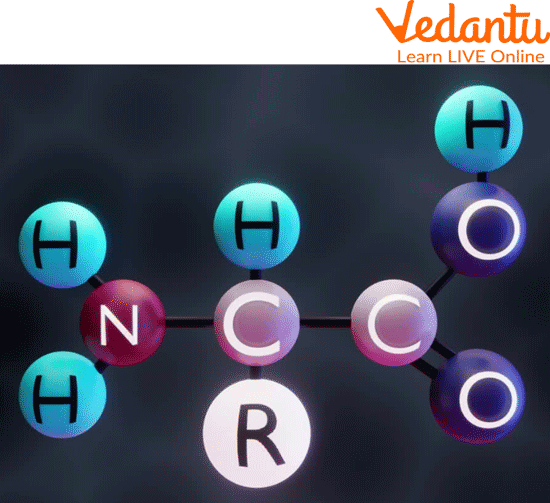




Introduction to Amino Acids
The building blocks of proteins are amino acids, which are the chemical compounds that come together to make proteins. These biomolecules are essential for human growth and development and are engaged in several biological and chemical processes in the body. There are around 300 amino acids found in nature.
Organic substances known as amino acids have basic amino groups R-CH(NH2)-COOH and carboxyl groups R-C(O)OH. Amino acids are the components found in proteins. Proteins and peptides are both made up of lengthy chains of amino acids. A total of twenty amino acids are used to produce proteins. Now let us learn more about amino acids.
General Properties of Amino Acids
The general properties of amino acids are shown below.
Both their melting and boiling points are extremely high.
Amino acids are white crystalline solids.
Few amino acids have a pleasant, tasteless, or bitter flavour.
The majority of amino acids are water soluble and insoluble in organic solvents.
Essential and Non-essential Amino Acids
Non-essential amino acids are those our body can easily produce. These include proline, glycine, serine, tyrosine, cysteine, glutamine, asparagine, arginine, aspartic acid, glutamic acid, and aspartic acid.
Other than these, nine other amino acids are necessary because our bodies cannot make them. Some important amino acids are isoleucine, histidine, lysine, leucine, phenylalanine, tryptophan, methionine, threonine, and valine.
Structure of Amino Acids
The general structure of amino acids is shown below.

Structure of Amino Acid
20 amino acids are found in nature, and they all share three structural characteristics: an amino group $\left(-\mathrm{NH}_3^{+}\right)$, a carboxylate group $\left(-\mathrm{COO}^{-}\right)$, and a hydrogen atom that is connected to the same carbon atom. Their $R$ group side-chain is what sets them apart from one another. There are 4 distinct groups connected to each amino acid's carbon atom.
These 4 categories are
COOH
a hydrogen atom
an amino group
a sidechain (R)
Sources of Amino Acids
Amino acids are essential for carrying out a variety of biological and chemical processes in various sections of our bodies, including the synthesis and repair of tissues, the production and operation of enzymes, food digestion, the movement of molecules, etc. Only a small number of amino acids, known as essential amino acids, can be produced by the body; therefore, they must be consumed regularly in the form of protein-rich diets.
Plant-based foods include broccoli, beans, beets, pumpkin, cabbage, almonds, dry fruits, chia seeds, oats, peas, carrots, cucumber, green leafy vegetables, onions, soybeans, whole grains, peanuts, legumes, lentils, etc., are sources of amino acids. Apples, bananas, berries, figs, grapes, melons, oranges, papaya, pineapple, and pomegranates are among the fruits high in amino acids.

Sources of Amino Acids
Functions of Amino Acids
There are two functions of amino acids-essential and non-essential amino acids.
Functions of Essential Amino Acids
Phenylalanine aids in enhancing memory and preserving a healthy neural system.
Valine has a crucial role in encouraging muscular growth.
The immune system is supported in its operations by threonine.
Serotonin hormones and vitamin B3 are both made using tryptophan. We need this serotonin hormone to keep our appetites in check, control our sleep cycles, and elevate our moods.
Functions of Non-essential Amino Acids
The functions of non-essential amino acids include
In addition to helping our bodies rid themselves of contaminants, alanine aids in the synthesis of amino acids like glucose.
In addition to acting as an antioxidant and giving our bodies resilience, cysteine is crucial for producing collagen. It alters the skin's suppleness and texture.
Glycine is essential for maintaining healthy cell growth and function and aids in the recovery of wounds. As a neurotransmitter, it functions.
Deficiency of Amino Acids
As was already noted, amino acids are the building blocks of proteins, and proteins are essential to practically every aspect of life. So, to maintain a healthy and balanced body, we must consume all nine essential amino acids each day. The pathological conditions that might result from an amino acid shortage include:
Anaemia
Insomnia
Diarrhoea
Depression
Hypoglycemia
Decrease in appetite
Fat accumulation in the liver
Skin and hair-associated concerns
Weakness, irritation, and headache
List of 10 Amino Acids
The names of the 10 amino acids are listed below.
Alanine
Leucine
Aspartic acid
Lysine
Asparagine
Methionine
Arginine
Proline
Cytosine
Phenylalanine
Cysteine
How can Amino Acids be Used to Make Proteins?
Proteins are created when peptide bonds join the amino acids. The protein is then folded into precise three-dimensional structures as a result of the forces of other amino acids and the effects of their R-groups.
Summary
In this article, we have discussed the general properties of amino acids, essential and non-essential amino acids, the structure of amino acids, sources of amino acids, function and deficiency of amino acids. The compounds known as amino acids are made up of an amine group, a carboxylic acid group, a hydrogen group and a side chain unique to each amino acid. An amino acid's primary constituents are carbon, hydrogen, oxygen, and nitrogen. They have a crucial role in biochemistry, where the term is typically used to refer to alpha-amino acids. Proteins are made up of linear chains of amino acids, which are used as the building blocks of amino acids. A wide range of proteins can be created by joining amino acids in different ways. We hope this article is beneficial for you, in case of any other doubts feel free to ask in the comments.
FAQs on Amino Acids for Kids
1. Why are amino acids called amphoteric?
The characteristics of amino acids range from basic to acidic. They are amphoteric as a result. Based on the pH of the solution, the amino acid takes on its predominant form.
2. What is zwitterion?
Even though we typically write amino acids with a carboxyl group and amino group, the real structure of amino acids is ionic and relies on pH. The carboxyl group donates a carboxylate ion by giving up a proton. An ammonium ion is formed when the amino group is protonated. Zwitterions or dipolar ions are the terms used to describe this structure.
3. Give an example of a transport protein and mention its function.
A protein used in transport is haemoglobin. It is concerned with getting oxygen to the cells.









